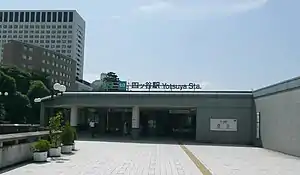Yotsuya Station
Yotsuya Station (四ツ谷駅, Yotsuya-eki) is a railway station in the Yotsuya district of Shinjuku, Tokyo, Japan, operated jointly by East Japan Railway Company (JR East) and Tokyo Metro. Several parts of the station are also located in the Rokubancho and Kojimachi neighborhoods of Chiyoda ward.
JC04 JB14 M12 N08 Yotsuya Station 四ツ谷駅 | ||||||||||||||||||||||||||||||||||||||||||||||||
|---|---|---|---|---|---|---|---|---|---|---|---|---|---|---|---|---|---|---|---|---|---|---|---|---|---|---|---|---|---|---|---|---|---|---|---|---|---|---|---|---|---|---|---|---|---|---|---|---|
 Akasaka entrance, with Sophia University in the background, August 2008 | ||||||||||||||||||||||||||||||||||||||||||||||||
| Location | 1 Yotsuya, Shinjuku, Tokyo (東京都新宿区四谷1丁目) Japan | |||||||||||||||||||||||||||||||||||||||||||||||
| Operated by | ||||||||||||||||||||||||||||||||||||||||||||||||
| Line(s) |
| |||||||||||||||||||||||||||||||||||||||||||||||
| Other information | ||||||||||||||||||||||||||||||||||||||||||||||||
| Station code |
| |||||||||||||||||||||||||||||||||||||||||||||||
| History | ||||||||||||||||||||||||||||||||||||||||||||||||
| Opened | 1894 | |||||||||||||||||||||||||||||||||||||||||||||||
| Services | ||||||||||||||||||||||||||||||||||||||||||||||||
| ||||||||||||||||||||||||||||||||||||||||||||||||
Lines
Yotsuya Station is served by the JR East Chūō Main Line with both Chūō Line (Rapid) and Chūō-Sōbu Line local services stopping here.
It is also served by the Tokyo Metro Marunouchi Line (station number M-12) and Tokyo Metro Namboku Line (station number N-08) subway lines. The station is 13.7 km from the Marunouchi Line terminus at Ikebukuro, and 7.8 km from the Namboku Line terminus at Meguro.[1]
All four lines at Yotsuya run north to south; however, the Chūō/Chūō-Sōbu Line and Marunouchi Line are mainly east-west lines, and somewhat counter-intuitively, while northbound Chūō Line trains are bound for Tokyo and southbound trains are bound for Shinjuku, northbound Marunouchi Line trains are bound for Shinjuku and southbound trains are bound for Tokyo.
Station layout
 Yotsuya entrance, August 2008
Yotsuya entrance, August 2008 Kojimachi entrance, August 2008
Kojimachi entrance, August 2008
JR East
The JR East part of the station consists of two island platforms serving four tracks. The station has a "Midori no Madoguchi" staffed ticket counter and "View Plaza" travel agency.[2]
| 1 | JC Chūō Line (Rapid) | for Ochanomizu and Tokyo |
| 2 | JC Chūō Line (Rapid) | for Shinjuku, Tachikawa, Takao, and Ōtsuki |
| 3 | JB Chūō-Sōbu Line | Ochanomizu, Kinshichō, Tsudanuma, Chiba |
| 4 | JB Chūō-Sōbu Line | for Shinjuku, Nakano, and Mitaka |
 Ticket gates at Akasaka exit
Ticket gates at Akasaka exit Platforms 1 and 2
Platforms 1 and 2 Platforms 3 and 4
Platforms 3 and 4
Tokyo Metro
The Marunouchi Line station is elevated with two side platforms serving two tracks. The Namboku Line station is underground with one island platform serving two tracks.
| 1 | M Tokyo Metro Marunouchi Line | for Shinjuku, Nakano-Sakaue, and Ogikubo |
| 2 | M Tokyo Metro Marunouchi Line | for Ginza, Otemachi, and Ikebukuro |
| 3 | N Tokyo Metro Namboku Line | for Komagome, Akabane-Iwabuchi SR Saitama Rapid Railway Line to Urawa-Misono |
| 4 | N Tokyo Metro Namboku Line | for Nagatachō, Shirokane-Takanawa, Meguro MG Tōkyū Meguro Line to Hiyoshi |
 Overview of the Marunouchi Line station, January 2011
Overview of the Marunouchi Line station, January 2011 Marunouchi Line platforms, July 2007
Marunouchi Line platforms, July 2007
History
Yotsuya Station opened on 9 September 1894[2] as a station on the Kobu Railway, the forerunner of the Chūō Line which was nationalized in 1906. Although the line was originally single-track, the section passing through Yotsuya was double-tracked in 1895 and quadruple-tracked in 1929.
The Marunouchi Line station opened on 15 March 1959, and the Namboku Line station opened on 26 March 1996.[1] Yotsuya was the southern terminus of the Namboku Line until the opening of Tameike-Sannō Station in 1997.
Passenger statistics
In fiscal 2013, the JR East station was used by an average of 92,431 passengers daily (boarding passengers only), making it the 45th-busiest station operated by JR East.[3] In fiscal 2013, the Tokyo Metro station was used by an average of 110,217 passengers per day (exiting and entering passengers), making it the 27th-busiest station operated by Tokyo Metro.[4] The average daily passenger figures for each operator in previous years are as shown below.
| Fiscal year | JR East | Tokyo Metro |
|---|---|---|
| 2000 | 86,886[5] | |
| 2005 | 88,976[6] | |
| 2010 | 89,295[7] | |
| 2011 | 88,104[8] | 99,957[9] |
| 2012 | 90,122[10] | 104,101[11] |
| 2013 | 92,431[3] | 110,217[4] |
- Note that JR East figures are for boarding passengers only.
Surrounding area
The station is situated in the Yotsuya neighborhood on the boundary between Shinjuku and Chiyoda wards.
- Akasaka Palace
- Kioi Hall
- St. Ignatius Church
Universities and schools
- Sophia University
- Japan Professional School of Education
- Tokyo Chinese School
- Yotsuya Elementary School
Hotels
- Hotel New Otani
- Mitsui Garden Hotel Yotsuya
References
- Terada, Hirokazu (July 2002). データブック日本の私鉄 [Databook: Japan's Private Railways]. Japan: Neko Publishing. pp. 212–214. ISBN 4-87366-874-3.
- 各駅情報(四ツ谷駅) [Station Information: Yotsuya Station] (in Japanese). Japan: East Japan Railway Company. Retrieved 14 September 2012.
- 各駅の乗車人員 (2013年度) [Station passenger figures (Fiscal 2013)] (in Japanese). Japan: East Japan Railway Company. Retrieved 17 September 2014.
- 各駅の乗降人員ランキング [Station usage ranking] (in Japanese). Tokyo Metro. Retrieved 17 September 2014.
- 各駅の乗車人員 (2000年度) [Station passenger figures (Fiscal 2000)] (in Japanese). Japan: East Japan Railway Company. Retrieved 14 September 2012.
- 各駅の乗車人員 (2005年度) [Station passenger figures (Fiscal 2005)] (in Japanese). Japan: East Japan Railway Company. Retrieved 14 September 2012.
- 各駅の乗車人員 (2010年度) [Station passenger figures (Fiscal 2010)] (in Japanese). Japan: East Japan Railway Company. Retrieved 14 September 2012.
- 各駅の乗車人員 (2011年度) [Station passenger figures (Fiscal 2011)] (in Japanese). Japan: East Japan Railway Company. Retrieved 17 September 2014.
- 駅別乗降人員順位表(2011年度1日平均) [Station passenger figures (Fiscal 2011)] (in Japanese). Japan: Tokyo Metro. Retrieved 17 September 2014.
- 各駅の乗車人員 (2012年度) [Station passenger figures (Fiscal 2012)] (in Japanese). Japan: East Japan Railway Company. Retrieved 17 September 2014.
- 各駅の乗降人員ランキング (2012年) [Station usage ranking (2012)] (in Japanese). Tokyo Metro. Retrieved 17 September 2014.
External links
| Wikimedia Commons has media related to Yotsuya Station. |
- Yotsuya Station information (JR East) (in Japanese)
- Yotsuya Station information (Tokyo Metro) (in Japanese)